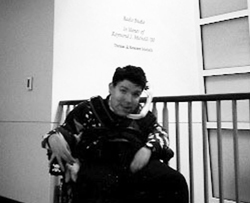 Showrunner Vince Gilligan concluded the AMC series, “Breaking Bad,” in a 75-minute finale on Sunday, Sept. 29. Millions of viewers tuned in to watch the airing of “Felina” at 9 pm, which reinforced “Bad” as one of television’s greatest drama series.
Showrunner Vince Gilligan concluded the AMC series, “Breaking Bad,” in a 75-minute finale on Sunday, Sept. 29. Millions of viewers tuned in to watch the airing of “Felina” at 9 pm, which reinforced “Bad” as one of television’s greatest drama series.
Five seasons and 62 episodes later, Walter White, the loving cancer-stricken high school chemistry teacher who transformed into the maniacal blue methamphetamine manufacturing drug kingpin, finally met his fate. Gilligan said during an interview on the after show “Talking Bad,” “This show was intended all along to be very finite. It’s a story that starts at A and ends at Z, as it were. It’s a very closed-ended thing.”
The stunning finale opened up with Walt in a car: weak, dying, and alone. His diminishing drive to live made it appear to viewers that it was over – but then he found the energy and desire to tie loose ends. He was fueled to go back to New Mexico and embrace both his fate and identity as Heisenberg. It is both odd and depressing seeing Walt on our television screens hit a low, for he is always portrayed as strong and intimidating.
Every move Walt made from that point forward seemed almost flawless and perfectly calculated. He first stopped at Elliot and Gretchen Schwartz’s residence, the owners of the prosperous “Gray Matter Technology” who stole Walt’s research and publically announced that Walt was useless to the establishment of such a company.
Walt would have normally handled his rage at the Schwartz’s by creating a blood bath and reaffirming that he “is the one who knocks,” however, he approached this situation differently in a way that was shocking to the viewers and a tad anti-climactic – he forced the couple to transfer his $10 million profit from his meth business into a trust for his children.
He confirmed this deal by fooling the couple into thinking there would be fatal repercussions from top-notch hit men for not going through with his demand. The alleged “hit men” ended up merely being Walt’s past street dealers, Skinny Pete and Beaver. It was comical when these dealers said they didn’t feel “morally right” for tricking the Schwartz’s, but in actuality, the business they are in isn’t “morally right” either.
With his children’s futures practically sealed, Walt visited one of the least popular characters on “Bad,” his wife, Skyler (Anna Gunn). He explained that he was only partially telling the truth for entering the drug business; Walt would consistently say that he did it for his family so they would never have to worry financially, but he finally admitted: ““I did it for me. I liked it. I was good at it, and I was alive.”
It was quite comforting knowing that Walt finally came to grips with his true self. The viewers have known that all along Walt was trying to persuade everyone around him that Walt was his identity and Heisenberg was his “front.” We have been waiting nearly six years as viewers for this moment when Walt finally released this from his chest, and a sense of relief encompassed us.
It was unveiled that the ricin Walt uncovered from his deserted house in the beginning of the season was for Lydia Rodarte-Quayle (Laura Fraser), who he later discovered was holding Jesse Pinkman (Aaron Paul) as a meth-slave in order to run her international drug business. We all would’ve liked to see Lydia go out in a more gory fashion, but at least she is gone for good.
There was one last thing Walt needed to do before he could accept the consequences of his actions for being Heisenberg, and that was to avenge the death of his brother-in-law, Hank Schrader (Dean Norris).
Walt created a rotating machine-gun contraption and placed it in the trunk of his old beat up, raggedy car. It is interesting and almost skeptical that a high school chemistry teacher could somehow fandangle together a monstrous killing machine.
With this killing machine, he entered the territory of the hitmen who killed Hank and who were holding Jesse. Although Walt initially planned on offing Jesse towards the beginning of the season, he tackled him to the ground just seconds before letting the bullets fire off. Jesse was completely below the line of fire, but Walt suffered from a gunshot wound in the crossfire.
A DEA agent couldn’t off Walt. A gang of hit men couldn’t off Walt. But a gunshot wound from his own contraption could off Walt? That seems unlike any scenario that would happen to Walt, but we’ll take it. It’s better than seeing Jesse and Walt go head to head in a death match.
With the entire gang of hit men dead, and the only two people left in the room being Walt and Jesse, it was time for face off… Or so we thought. Walt, the big, mean, killing machine, wimped out and gave Jesse the opportunity to shoot him by tossing him over a handgun. “Do it. You want this… I want this,” Walt said.
Jesse refused to end his life, and instead drove away and embraced his freedom – although, we all know he never truly will be “free”. Jesse will always be a prisoner of his own thoughts and battle the psychological effects from his years of being partners with Walt.
The scene pans out with a shot of Walt. Dead. Lying in a pool of his own blood. Smiling.
Badfinder’s “Baby Blue,” whose lyrics say, “The special love I have for you, baby blue,” played as “Breaking Bad” came to an end, referring to the love Walt had for his blue methamphetamine. The upbeat song gave viewers a sense that this circle of life that Walt created finally came to a full 360.
The title “Felina” was interpreted by some fans as the chemical symbols for Iron (Fe), Lithium (Li), and Sodium (Na), or “blood, meth, and tears.” “Bad” fans did not want to part with the show, but if it were to be extended any longer, the show would’ve lost its flavor – and this spectacular finale ended the show in a way that did the series justice.
Walter White may have died, but his legacy as Heisenberg that he created for nearly six years, will live on as being one of the greatest characters a drama series has ever had in one of the greatest drama television shows ever seen.
PHOTO TAKEN from stories.illinoisstate.edu


